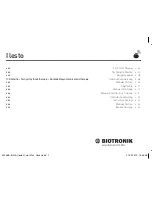
11
Product Description
Therapeutic and Diagnostic Functions
Diagnostic functions
•
Data from implantation and the most recent interrogations and follow-ups are
recorded as well as arrhythmia episodes; they are stored together with other
data to assess patients and the state of the device at any time.
•
To check the lead for proper functioning, an automatic impedance measure-
ment using subthreshold pacing pulses is performed in the device.
•
Leadless ECG function: For all device types, far-field derivation can be mea-
sured without external leads between the right ventricular shock coil and
housing, which, depending on the implantation site, corresponds to ECG
derivation II or III (Einthoven).
•
Once a telemetry connection has been established during a test procedure in
an in-office follow-up, the leadless ECG and the IEGM are displayed with
markers.
Antitachycardia pacing
•
The ICD can treat ventricular tachycardia with antitachycardia pacing (ATP);
ATP can also be delivered in the VF zone (ATP One Shot) when the stability cri-
terion indicating that this will be effective before shock delivery (monomorphic
rapid VTs) is met.
•
Depending on the device type, the device program contains not only the ICD
functions but also all pacemaker functions for 1, 2, or 3 chambers. The heart
rhythm is continuously monitored; each arrhythmia is classified according to
the heart rate and the adjustable detection criteria. Depending on the preset
values, antibradycardia as well as antitachycardia therapy is inhibited or deliv-
ered.
Cardioversion, defibrilla-
tion
•
The ICD can treat ventricular tachyarrhythmia with cardioversion and/or defi-
brillation. Shock polarity and energy can be programmed individually. Shock
energies between 2.0 and 40 J are possible. Before delivery of the shock, the
ICD can be set to only deliver a shock when ongoing tachyarrhythmia is con-
firmed; during this time period the device can identify spontaneous conversion
of the tachyarrhythmia and cancel the charging process if necessary.
•
The shock paths can be set between the different shock coils (SVC/RV) and/or
the housing.
Antibradycardia pacing and
CRT
•
Innovative rate hystereses, automatic sensor functions, and a night program
promote the patient's intrinsic rhythm, avoid overdrive pacing, and facilitate
adaptation of the device to the individual needs of the patient.
•
Setting an upper tracking rate for the atrium prevents unspecific atrial pacing,
thus reducing the risk of pacemaker-mediated tachycardia.
•
Positive AV hysteresis functions support the intrinsic conduction and thus the
natural contraction sequence. Negative AV hysteresis functions support the
cardiac resynchronization therapy by maintaining pacing in stressful situations.
•
For resynchronization of the ventricles, triple-chamber devices have functions
for multisite ventricular pacing with possible VV delays in either direction.
•
To ensure that no additional surgery is necessary in case of a left-sided
increase of pacing threshold or undesired phrenic nerve stimulation, different
pacing polarities can be set for the left ventricular lead with a triple-chamber
device.
•
Automatic active capture control is available for the right and left ventricle with
automated tracking of the pacing threshold or automatic threshold monitoring
(ATM) for trend analysis.




























